Małgorzata Palac-Siczek, Maciej Pilch, *Lidia Zawadzka-Głos
Profile of paediatric patient with nasal bone fracture
Profil pacjenta pediatrycznego ze złamaniem kości nosa
Clinical Department of Paediatric Otolaryngology, Medical University of Warsaw, Poland
Head of Department: Lidia Zawadzka-Głos, MD, PhD
Streszczenie
Wstęp. Nos należy do części twarzy, które najczęściej ulegają urazom u dzieci i dorosłych. Ocena pacjenta pediatrycznego po urazie nosa jest trudna i często wymaga wielokrotnego powtarzania badania przedmiotowego przed właściwą kwalifikacją do leczenia operacyjnego. Uraz kości nosa może być zarówno izolowany (co stanowi większość urazów nosa), jak i wchodzić w skład urazu wielomiejscowego twarzy. Ważne są czas interwencji zabiegowej oraz staranna technika wykonania zabiegu, gdyż oba czynniki implikują niejednokrotnie dalszy rozwój, a tym samym ostateczny wygląd nosa i decydują o jego dalszym prawidłowym funkcjonowaniu.
Cel pracy. Celem pracy jest określenie związku wieku oraz płci z częstością oraz mechanizmem urazu u pacjenta pediatrycznego. Analizie poddano również długość czasu potrzebnego na podjęcie decyzji o interwencji zabiegowej oraz czas hospitalizacji pacjenta w związku z tą procedurą.
Materiał i metody. Praca przedstawia analizę 54 przypadków dzieci w wieku 2-17 lat operowanych z powodu urazu kości nosa w Klinicznym Oddziale Otolaryngologii Dziecięcej Uniwersyteckiego Centrum Klinicznego w Warszawie w okresie od 1 stycznia do 31 marca 2018 roku i została oparta na dokumentacji medycznej omawianych przypadków.
Wyniki. Większość przypadków stanowili chłopcy (65%). Wiekowo dominowały 4- i 5-latki oraz 14-latki (odpowiednio po 13% przypadków). Dominującymi mechanizmami urazu były: upadek (41%), pobicie (24%) oraz uprawianie sportu (26%). Najczęściej pacjenci byli poddawani procedurze zabiegowej w 6.-8. dobie od doznanego urazu (65%), a długość okresu hospitalizacji wynosiła 2 dni (69%).
Wnioski. Uraz nosa u pacjenta pediatrycznego jest najczęściej izolowanym złamaniem kości nosa u chłopców w wieku rozwojowym. Najczęstszymi mechanizmami urazu są u takiego pacjenta bójka lub wypadek w trakcie uprawiania sportu. Złamanie kości nosa w tego typu urazie może być nastawione w przeważającej części przypadków w ciągu tygodnia od urazu, a okres hospitalizacji związany z interwencją zabiegową zwykle jest procedurą jednodniową lub nie przekracza 2 dni.
Summary
Introduction. The nose is one of the most frequently injured areas on the face both in children and adults. The evaluation of paediatric patients with nasal injury is a challenge, and it often requires repeated physical examinations before referring the patient for surgical treatment. Nasal bone injury can either be isolated (prevalent type) or constitute an element of multiple-site facial injury. Essential aspects associated with the surgical treatment of nasal bone injuries include the timing of surgical intervention and adherence to meticulous surgical technique. Both factors are often implicated in treatment outcome and hence determine the final appearance of the nose and its function.
Aim. The aim of study is to analyse the relation of patients age and sex compared to mechanism of trauma with paediatric patients. This study also analysed the length of period from injury to surgical intervention and time of hospitalization needed.
Material and methods. The present paper contains an analysis of a total of 54 cases of children aged 2 to 17 years, who were operated on because of nasal bone injury in the Department of Paediatric Otolaryngology, University Clinical Centre in Warsaw, in the period from 1.01.2018 until 31.03.2018. The analysis is based on the medical records of the study patients.
Results. The majority of cases were boys (65%). With respect to age, 4- and 5-year-olds, and 14-year-olds, were the predominant subgroups (13% of all cases, respectively). The dominant mechanisms of injury included falls (41%), beating (24%) and sports activities (26%). The patients typically underwent a surgical procedure on days 6-8 after the injury (65%), and the period of hospitalization was 2 days (69%).
Conclusions. The most common nasal trauma of pediatric patient, majority boys, is the isolated fracture of nasal bone related to sports injury and beating. The fracture can be resettled mostly within one week after trauma and hospitalization takes one to two days.
Introduction
Craniofacial injuries are nowadays a significant clinical problem in the daily practice of on-call paediatric otorhinolaryngologists. This can be attributed, among others, to civilizational factors, though the pathogenesis of paediatric traumatology is diverse and varies across age groups (1).
The clinical evaluation of patients at a developmental age after an injury is a unique challenge because of the distinctive nature of the history-taking procedure and physical examination as well as anatomical differences in the affected body region and the local condition immediately post-injury compared to the adult population. Another key factor in this age group is the responsibility that weighs on the clinician making therapeutic decisions, related to the long-term sequelae of the injury itself and its management (1-3).
The nose is an anatomical subunit which, given its location, structure and prominent protrusion from the face, is most commonly affected by injuries, usually of isolated nature. However, on account of its location, the nose is subjected to forces with the same directions as those involved in the biomechanics of injuries of the maxillo-ethmoidal complex. Therefore, it is important to note that in addition to the direction of the acting force a crucial factor determining whether an injury represents the isolated or multi-site type is the intensity of that force. Naturally, in other types of craniofacial injuries the force is considerably greater (4).
There are many different classifications of craniofacial injuries. The most popular and, at the same time, the simplest and most clinically useful classification system was proposed by Renè Le Fort (4, 5) over a century ago. Le Fort divided injuries of the midface into the following types:
– Le Fort type I: horizontal maxillary fracture, separating the teeth from the upper face; the fracture line passes through the alveolar ridge, lateral nose and inferior wall of the maxillary sinus,
– Le Fort type II: pyramidal fracture, with the teeth at the pyramid base, and nasofrontal suture at its apex; fracture arch passes through the posterior alveolar ridge, lateral walls of maxillary sinuses, inferior orbital rim and nasal bones (often associated with comminuted nasal fractures),
– Le Fort type III: craniofacial disjunction; transverse fracture line passes through nasofrontal suture, maxillo-frontal suture, orbital wall, and zygomatic arch/zygomaticofrontal suture (“plate face”).
An important aspect during the laryngological examination of the youngest patients is the exclusion of multi-site injury. It is only after ascertaining that the nasal injury is isolated, and there is no direct threat to the life and health of the child, that further decisions can be made regarding injury management (4-7).
The visual and palpatory assessment of paediatric patients immediately post-injury is difficult. The absence of classic symptoms accompanying nasal injuries in adult patients – such as bleeding, crackling of bone fragments or nasal blockage and significant swelling – which mask the deformation of the structure secondary to the injury prompts the clinician to adopt the “wait-and-see” approach including close follow-up of the patient combined with symptomatic treatment of post-traumatic oedema. In the majority of cases the child is examined by a laryngologist every 2-3 days, and the repositioning of nasal bones is postponed until days 7-10 after the injury. Adherence to the above procedure ensures that a fracture is not overlooked, as it is initially obscured by rapidly growing tissue oedema, and displaced structures can be restored to their anatomical positioning.
Failure to perform repositioning of the fractured elements after nasal injury often leads to serious developmental effects including impairment of facial symmetry and aesthetics (potential disturbance of growth centres) as well as physiological disorders of the nose, sinuses and functionally related structures (tear ducts, olfactory groove) (2).
The surgical intervention itself, especially when it is performed without adequate knowledge of the specific features of the injury in children or undertaken too early, is associated with yet another clinically important aspect. Surgical intervention which is very traumatic or performed without appropriate accuracy may require re-surgery – either immediately after the injury (repair by re-repositioning) or deferred in time (rhinoplasty, septoplasty), or cause complications with a significant impact on further development of the patient (perforation of the nasal septum, abnormal craniofacial growth) (1, 2, 8).
Aim
The aim of the study is to analyze the cases of children aged 0-18 years who reported to the Clinical Department of Paediatric Otolaryngology, University Clinical Centre in Warsaw, between 1.01.2018 and 31.03.2018, with a diagnosis of nasal bone fracture, and were treated surgically on an emergency basis. The study compared a number of parameters including the structure of age and sex, the mechanism of injury and its coexistence with other craniofacial injuries, the timing of surgical intervention, and the length of patient hospitalization.
Material and methods
The analysis was conducted on the basis of medical records of patients diagnosed with nasal fracture and hospitalized in the Clinical Department of Paediatric Otolaryngology, University Clinical Centre in Warsaw, between 1.01.2018 and 31.03.2018 (preliminary examination, clinical follow-up, surgical protocols, and records of follow-up appointments in the laryngology outpatient clinic).
Results
A total of 54 patients aged 2 to 17 years were admitted to the Clinical Department of Paediatric Otolaryngology, University Clinical Centre in Warsaw, between 1.01.2018 and 31.03.2018 (fig. 1). The group comprised 35 boys and 19 girls (65 and 35% of the study group, respectively) (fig. 2). All the children underwent surgical treatment on an emergency basis, which involved the repositioning of fractured and displaced nasal bones.
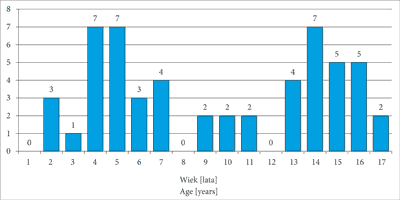
Fig. 1. Age
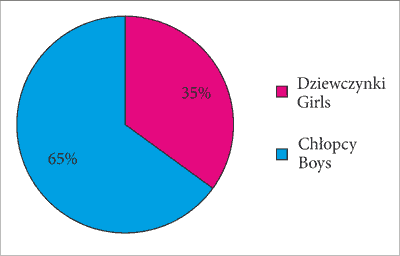
Fig. 2. Sex
Most of the injuries discussed in the study were observed in patients during puberty: the study group comprised 21 cases of nasal injury in children aged 13 to 16 years. In this group, a statistically significant predominance was noted for the male sex (nearly 75% of cases). Kindergarten-age children formed another large age subgroup. The study material included 18 cases of nasal injury in children aged 3 to 6 years, with no predilection for any sex.
In a total of 48 patients, the nasal injury was isolated, and in 6 cases it also involved other facial areas: in 4 cases, it was extensive craniofacial injury with sinus wall fracture, in 1 case the injury involved the orbit, and 1 patient suffered an injury to the upper lip and mucous membrane covering the upper alveolar process, which required concurrent surgical management of oral wounds (fig. 3).
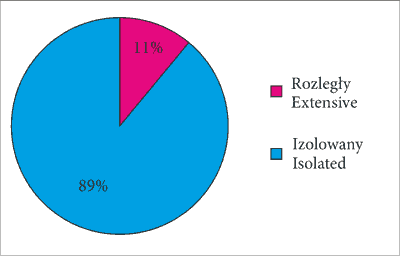
Fig. 3. Scope of injury
Most commonly, the time necessary to achieve appropriate conditions for local evaluation (corresponding to the resolution of post-traumatic oedema) was 7 days (16 patients), and 8 days (10 patients). In some patients, it was necessary to postpone the surgery until day 9 (4 cases). One patient underwent the procedure on day 10, and another one on day 14 after the injury. Nasal bone repositioning already on day 4 post-injury was possible in 5 patients, on day 5 – in 7 patients, and on day 6 – in 9 patients. The earliest surgical intervention was performed on day 2 post-injury (in 1 patient) (fig. 4).
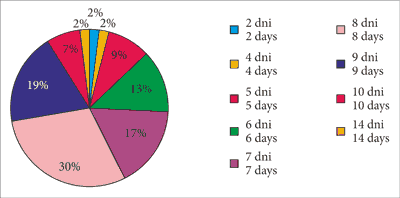
Fig. 4. Time after injury
The length of hospital stay in the majority of the study patients was 2 days (37 children). A considerable subgroup underwent treatment on a same-day-surgery basis. Four patients were hospitalized for 3 days. One patient stayed in the Department for 4 days (fig. 5).
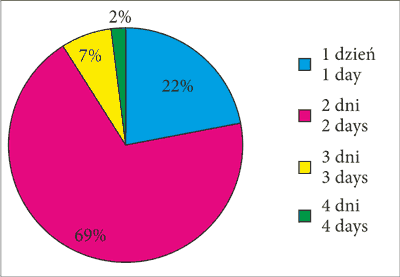
Fig. 5. Length of hospitalization
The dominant mechanisms of trauma included falls (41%), injuries inflicted by a third person or arising during a physical altercation (21%), and injuries suffered during sports activities – at school and on an extracurricular basis after school (26%) (fig. 6). It must be stressed that the group of children who suffered an injury after a fall was dominated by younger patients (the largest age subgroup comprised 4- and 5-year-olds, and children under 7 year old constituted 68%), whereas injuries inflicted by third persons and arising during sports activities were more prevalent in older children. Adolescents who were injured after being punched or beaten constituted 69% of cases involving the injury mechanism discussed, while in the group of children with nasal injury associated with sports activities adolescents accounted for 71%.
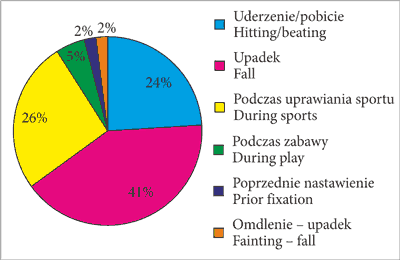
Fig. 6. Mechanism of injury
Discussion and conclusions
It is an indisputable and frequently highlighted clinical observation that traumatic nasal injuries are among the most common physical injuries both in children and adults. They occur at a far greater frequency in boys than in girls (in our study material, boys represented 65%, and girls 35% of the study group) (fig. 2), though the ratio (as shown in the material under analysis) is slightly more even in the paediatric population – in adults, the male-female ratio is estimated to be slightly higher than 2:1. This may be due to the similar aetiology of injury in younger age groups (learning to walk, curiosity about the world in patients of developmental age, and the wish to explore the outside world, which are not always matched by sufficient gross motor skills in young children). Injuries of this origin are noted both in girls and boys of the nursery and kindergarten age, as the pattern of motor development in children applies to both sexes equally.
In a vast majority of patients’ nasal trauma is an isolated injury. This was also shown in our study, where 89% of cases were isolated injuries (fig. 3). In the group of patients with multiple-site injury (11%), the dominant mechanisms of trauma were intentional beating by a third person (33%) and physical trauma suffered while practising sports (33%). The above numbers corroborate the thesis about the magnitude of inflicted force. A force of higher intensity often leads to extensive injuries affecting multiple facial bones and soft tissues.
The largest age subgroups of children with nasal bone injury in our study material comprised 4- and 5-year-olds, and 14-year-olds (13%, respectively) (fig. 1). In the first age subgroup, the gender distribution was balanced (the girl-to-boy ratio was 4:3 for 4-year-olds and 3:4 for 5-year-olds), while in the subgroup of 14-year-old patients the male gender predominated (2:5), and the most prevalent mechanism of trauma was injury inflicted by a third person or in a physical altercation. Gender distribution depending on age, and in particular the male predominance among adolescents, highlights the importance of the origin of injury. Late school-age boys, similarly to adults, more commonly practise high-injury sports. In addition, they tend to use violent means in resolving their conflicts with peers of the same sex. A potentially significant difference between adult men and school-age adolescents of the male sex is that the incidence of injuries in the adult population is more heavily impacted by the consumption of alcohol. However, the effect of alcohol as a factor underlying predilection to injury in adolescents was not the subject of the present study, and it needs further prospective research. In the material under analysis, there were no cases of coexisting intoxication with alcohol or other substances.
The predominant mechanisms of injury in 54 cases under study were falls followed by hitting the floor, pavement or a standing object/furniture item, i.e. situations where the incident was caused by accidental tripping (41% of cases). The above mechanism was the most prevalent one in the younger subgroups (68% of victims were children aged 2-7 years). Injuries implicating third persons (24%) and sports injuries (26%) were predominant in the group of older paediatric patients. In the group of beaten children, adolescents represented 69%, and in the group injured while practising sports – 71%. A small group of younger children (approximately 5%) were injured while playing in the playground (or in a playroom). Also, marginal groups comprised nasal injuries resulting from hitting the floor after fainting (2%) and iatrogenic surgical trauma in a patient who needed repeated repositioning of incorrectly set bones (fig. 6). Consequently, the impact of civilizational factors including greater access to a variety of contact and team sports is noticeable only in the older age subgroup (adolescents). Among younger children, the mechanism underlying the injury still seems – in most cases – accidental, resulting in uncomplicated fractures with a break in one of the nasal bones, or fractures with an “open book” pattern (more difficult to diagnose) in which the nasal septum is collapsed and both nasal bones splayed out. On the one hand, the technique applied in the course of surgical management of such fractures is simple (restoration of shape of the collapsed bones). On the other hand, it should be noted that accurate repositioning of bone fragments determines further development of a small nose, and appropriate catamnesis requires meticulous physical examination of the local condition and, if necessary, referral for surgical re-intervention. The above approach is necessary, as it is not easy to determine whether the internal packing and stabilization provided sufficient support for the repositioned nasal bones and were employed for an appropriate time, especially in the light of factors including children’s mobility (critical to normal physical development), occasionally unclear history of repeated injury or the risk of premature removal of nasal packing or external fixation of the realigned nose by the paediatric patient.
The vast majority of patients could undergo a surgical intervention approximately 1 week after the injury (with 65% of patients being children treated surgically on days 6-8 after the injury). In 9% of cases, the duration of surgical treatment had to be extended to 9-10 days. One patient did not undergo surgery until day 14 after the injury. In 22% of patients, nasal bone repositioning could be performed already on days 4-5 after the injury. An analysis of the study cases confirms the widely known optimal timing for nasal bone repositioning in children. i.e. the period between days 7 and 10 after the injury (fig. 4). Nasal bone reduction after this period is usually performed in older patients, with complex comminuted fractures, often involving multiple sites, and it may not always be sufficiently effective (such patients should be referred for later surgical procedures: rhinoplasty or septoplasty). However, when earlier surgical intervention is attempted, there is a risk of insufficiently accurate realignment of bone fragments. Such cases may require patient referral for another repositioning procedure during the evaluation performed after the removal of nasal packing and external fixation.
The length of hospital stay was 2 days in the majority of cases (69%). In some of the patients (22%), the repositioning of nasal bones could be performed on a same-day surgery basis. In a minor proportion of the study patients (7%), it was necessary to extend the period of hospitalization to 3 days. The material studied contained just 1 case of hospitalization lasting 4 days (2% of the study group) (fig. 5). The authors of the present study highlight the fact that in the predominant majority of cases the procedure of nasal bone repositioning can and should be performed on a same-day surgery basis.
The problem of nasal injuries in the paediatric population is important from the practical point of view. Accurate evaluation of the local condition – with exclusion of complications (e.g. haematoma of the nasal septum) and appropriate timing of referral for a suitable type of surgical intervention – may prevent repeated and prolonged treatment of young patients associated with hasty therapeutic decisions. In addition, it may help to avoid technically complex rhinological operations in a more distant future, performed under general anaesthesia and accompanied by intensive discomfort typically associated with surgical treatment. Therefore, both clinicians and parents should give appropriate consideration to injuries involving the child’s nose, even though at first sight they might appear insignificant.
Piśmiennictwo
1. Gryczyńska D: Otorynolaryngologia dziecięca. Alfa Medica Press, Bielsko-Biała 2007.
2. Krzeski A: Wykłady z chirurgii nosa. Via Medica, Gdańsk 2005.
3. Behrbohm H, Kaschke O, Nawka ET, Swift A: Ear, nose and throat diseases. With head and neck surgery. Thieme, 2009.
4. Janczewski G: Otorynolaryngologia praktyczna. Tom I. Via Medica, Gdańsk 2005.
5. Janczewski G, Osuch-Wójcikiewicz E: Ostry dyżur laryngologiczny. Alfa Medica Press, Bielsko-Biała 2003.
6. Habal MB, Ariyan S: Facial fractures. Decker Inc, Baltimore 1989.
7. AL-Ani R, AL-Robaeej HH: Management of fractured nose. Tikrit Medical Journal 2011; 17(1): 119-126.
8. Krzeski A: Podstawy chirurgii nosa. Via Medica, Gdańsk 2004.





